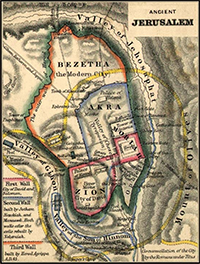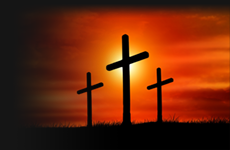
Geography of Jerusalem
Jerusalem is thought to be the same as the city of Salem in Patriarchal times. It was there that Melchizedek, the king of righteousness lived, and to whom Abraham paid a tithe, (Genesis 14:18-20).
During the times of Joshua and the conquests, the city was known as "Jebus," because Canaanites called "Jebusites" lived there. Despite Joshua's conquest of the area, Jebusites remained. Though it wasn't until David that the stronghold on Zion was taken, we know that Jebusites remained thereafter because the bible reports that David purchased the ground for the future Temple from Araunah the Jebusite.
The Mountains
Jerusalem sits upon a plateau 2500 feet above sea level and bordering the Judean desert toward the east. This desert descends about 4,000 feet to the Dead Sea 10 miles to the east. The western side faces the Judean mountains, and the east, south and western sides have steep valleys that made Jerusalem easier to defend militarily.
The greater city rested on top of four mountains, (hills actually), two of which have the biblical names of Mount Zion and Mount Moriah. Between these two hills was a valley that the Romans called the Tyropoeon. Zion was basis of the south-western part of the city and was the largest of the hills. Although the word "Zion" often referred to this hill in the old Testament, it also occasionally referred to Moriah or the greater city in general. The stronghold of the Jebusites that was on Mount Zion was taken by David, and thereafter in the Psalm he told of God's choice of Zion...
"For the Lord has chosen Zion; He has desired it for his dwelling place:
'This is My resting place forever; here I will dwell, for I have desired it.'"
Psalm 132:13-14
Zion was the hill that housed the "Upper City" in the time of Jesus, and it is there that king David built his palace, a palace that was used by future kings as well.
Mount Moriah was located north-east of Zion and is about 2400 feet high. It was located between the Kidron Valley and the Tyropoeon. During his reign, Solomon built an elevated platform on the hill, and constructed walls on the eastern, southern and western sides. It was on this high platform that the Temple would be built. It was thought that the tallest point was used for placement of the Holy of Holies. and that this had been the place where Abraham had been tested by the offering of his son, Isaac, (Genesis 22:2). Moriah's southern slope from the southern wall of the platform to the valleys below was called Ophel.
Mount Acra sat between the Hinnom and Tyropoeon valleys north of Mount Zion. The Seleucids under Antiochus Epiphanes built a fortress here in 168 BC, but this was later destroyed by Simon Maccabee. He thereafter lowered the height of Mount Acra to make it lower than Mount Moriah on which the temple stood.
Mount Bezetha is north of the Antonia Fortress and was not a part of the city of Jerusalem until the mid-first century AD. The so-called "Third Wall" of Josephus was begun by Herod Agrippa in AD 44, but was not completed until the Jewish rebels did so in AD 66. The areas enclosed by this wall were called the "New City."

The Valleys
As mentioned above, valleys around Jerusalem were important to its protection. Valleys on the west, south and east of the city were 200-400 feet deep, making attack from these directions virtually impossible. According to Josephus, the vulnerable northern side of the city was protected by a 100 foot tall wall with ninety towers. Although he finally conquered and destroyed Jerusalem in AD 70, the Roman General (and future emperor) Titus declared, "...if it had not been for the internal dissensions, the city could never have been taken."
The eastern valley of Kidron was also known as the "Valley of Jehoshapat." It separated the city from the Mount of Olives. The Tyropoeon Valley joined Kidron south of Mount Moriah and ran north between Zion and Moriah. The Hinnom Valley created the western and southern protection for the city. Its southern-most part was called "Gehenna," (or "Tophet"). This was a "place of fire" lamented by the prophet Jeremiah as the location wherein Moloch was worshiped with the abomination of human sacrifice, (Jeremiah 7:31). In New Testament times, Gehenna had become a huge, foul garbage heap of excrement with the carcasses of animals and the bones of unclaimed dead. Because of its history and foul nature, the term Gehenna became associated with divine punishment, or "hell."
